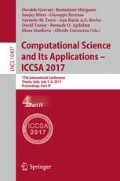Abstract
Included among other mathematical software, dynamic geometry software has the great advantage of enabling teachers and learners to visualize and interactively control mathematical models. However they are not used in real classrooms as widely as expected. One reason is that it is not so easy for ordinary teachers and learners to install those software onto personal computers and to master the skills needed to operate them appropriately. As a result, teachers do not have enough knowledge about the theme and the manner in which those software will be used effectively. To overcome this difficulty, the extensions associated with some dynamic geometry software are being developed so that the teaching materials generated by them can be adapted to plugin-less web technology. In this paper, the author explains some case studies which illustrate the software’s influence on learners’ mathematical cognition. The method to identify the above mentioned influence will be applicable to wide range of researches concerning the interaction between learners’ reasoning processes and information technology.
Access this chapter
Tax calculation will be finalised at checkout
Purchases are for personal use only
References
Laborde, C.: Experiencing the multiple dimensions of mathematics with dynamic 3D geometry environments: illustration with Cabri 3D. Electron. J. Math. Technol. 2(1), 38–53 (2008)
Richter-Gebert, J., Kortenkamp, U.: Interactive Geometry with Cinderella. Springer, Heidelberg (2012)
Hohenwater, M., Preiner, J.: Dynamic mathematics with GeoGebra. J. Online Math. Appl. 7 (2007). Article ID 1448
Fest, A., Hiob, M., Hoffkamp, A.: An interactive learning activity for the formation of the concept of function based on representation transfer. Electron. J. Math. Technol. 5(2), 169–176 (2012)
Lavicza, Z.: Integrating technology into mathematics teaching: a review. ZDM Int. J. Math. Educ. 42(1), 105–119 (2010)
Ginns, P., Hu, F.T., Byrne, E., Bobis, J.: Learninng by tracing worked examples. Appl. Cogn. Psychol. 30, 160–169 (2016)
von Gagern, M., Kortenkamp, U., Richter-Gebert, J., Strobel, M.: CindyJS. In: Greuel, G.-M., Koch, T., Paule, P., Sommese, A. (eds.) ICMS 2016. LNCS, vol. 9725, pp. 319–326. Springer, Cham (2016). doi:10.1007/978-3-319-42432-3_39
von Gagern, M., Richter-Gebert, J.: CindyJS Plugins. In: Greuel, G.-M., Koch, T., Paule, P., Sommese, A. (eds.) ICMS 2016. LNCS, vol. 9725, pp. 327–334. Springer, Cham (2016). doi:10.1007/978-3-319-42432-3_40
Montag, A., Richter-Gebert, J.: CindyGL: authoring GPU-based interactive mathematical content. In: Greuel, G.-M., Koch, T., Paule, P., Sommese, A. (eds.) ICMS 2016. LNCS, vol. 9725, pp. 359–365. Springer, Cham (2016). doi:10.1007/978-3-319-42432-3_44
Ancsin, G., Hohenwater, M., Kovacs, Z.: GeoGebra goes mobile. Electron. J. Math. Technol. 5(2), 159–168 (2012)
Hake, R.R.: Interactive-engagement versus traditional methods - a six-thousand-student survey of mechanics test data for introductory physics courses. Am. J. Phys. 66(1), 64–74 (1998)
Hoellwarth, C., Moelter, M.J.: The implications of a robust curriculum in introductory mechanics. Am. J. Phys. 79(5), 540–545 (2011)
Richter-Gebert, J., Kortenkamp, U.: The power of scripting: DGS meets programming. Acta Didactica Napocensia 3(2), 67–78 (2010)
Acknowledgements
The author is grateful to Professor Takeo Noda for proposing the theme and the contents used in this research. The author is also grateful to Professor J\(\ddot{\mathrm{u}}\)rgen Richter-Gebert, Professor Ulrich Kortenkamp, and their colleagues for their great efforts to develop Cinderella and CindyJS.
This work was supported by JSPS KAKENHI (15K01037).
Author information
Authors and Affiliations
Corresponding author
Editor information
Editors and Affiliations
Rights and permissions
Copyright information
© 2017 Springer International Publishing AG
About this paper
Cite this paper
Kaneko, M. (2017). Using Tangible Contents Generated by CindyJS and Its Influence on Mathematical Cognition. In: Gervasi, O., et al. Computational Science and Its Applications – ICCSA 2017. ICCSA 2017. Lecture Notes in Computer Science(), vol 10407. Springer, Cham. https://doi.org/10.1007/978-3-319-62401-3_15
Download citation
DOI: https://doi.org/10.1007/978-3-319-62401-3_15
Published:
Publisher Name: Springer, Cham
Print ISBN: 978-3-319-62400-6
Online ISBN: 978-3-319-62401-3
eBook Packages: Computer ScienceComputer Science (R0)

